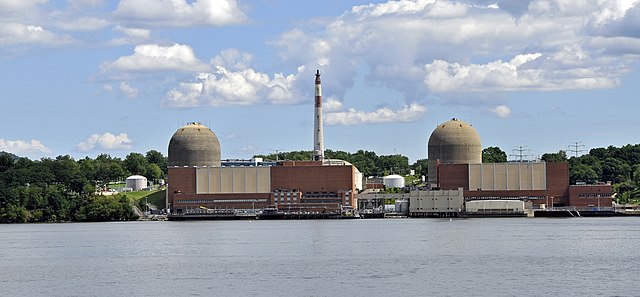
What is a thorium reactor? A thorium reactor is a nuclear reactor that is powered with thorium and not uranium. Let’s look at how a current nuclear reactor works and then look at how a thorium reactor would work.
Nuclear reactors work on the principle of nuclear fission. This is where an atom of a material, usually uranium or plutonium, is split in two. Atoms are made up of electrons, protons, and neutrons. Different atoms have different amounts of each one, but they are all held together by the strong force, which is one of the four fundamental forces. The strong force is a form of energy, holding the particles together. A neutron is fired at the atom with such speed that it knocks all of the electrons, protons, and neutrons out of place, and they fly off and form new, smaller atoms. They release neutrons, which zoom off, and they also release energy from the strong force. Each new atom is smaller and doesn’t need enough energy in the strong force to keep it together. That excess energy is released, and this is where the energy from a nuclear reaction comes from. The energy from one atom isn’t enough, but if the reaction goes critical, then the released neutrons from the first atom hit other atoms and the process continues until all of the fuel is used up. Not all atoms will split and start a chain reaction. Nuclear reactors use unstable, heavy elements, such as uranium-235 and plutonium-239.
A nuclear reactor takes the energy generated by nuclear fission to heat water, which is also used to keep the nuclear fuel from exploding. This heated water then heats a different source of water to boiling point and the steam produced is used to turn a turbine, making electricity. It works well and there are no greenhouse emissions, as there are with fossil fuels. However, there are several problems with nuclear power. The fuel gets very hot because there is a huge amount of energy and there is the risk of a meltdown or an explosion. This is not common, but it has happened. 1.5% of all nuclear power plants have had accidents, Chornobyl being the most famous. The fuel can also be used to build nuclear bombs, which is obviously a problem. One of the biggest problems is the fuel is highly radioactive and has to be buried until it is safe, which could be over 100,000 years. Nobody can make something safe for that long. Nuclear power is a good source of power, but there are too many problems.
So, what is a thorium reactor? A thorium reactor works in the same way as a nuclear reactor, except the thorium has to undergo some changes before it can be used. Thorium is not a fissile material, which means it does not undergo fusion directly. It has to be changed into a different material, called uranium-233. This is done by adding neutrons to the thorium. Once it changes into uranium-233, it is fissile and it can be used for a nuclear chain reaction to create power. To make the thorium into uranium-233 you have to add extra enriched uranium to produce the neutrons, and that gets very expensive, which is the main reason why thorium reactors lost out to uranium reactors in the 1950s and 60s. Thorium is being cited as the future of nuclear power. It is said to be more available, much safer, and it produces less harmful waste. Is that true?
There is three times more thorium in the world than there is uranium. That is true, but all of the thorium is in the Earth’s crust and needs to be mined. Uranium is mined, but there is also a lot of uranium in the ocean, which can be extracted. It is very costly at the moment, but the process is getting cheaper.
It is said that thorium can’t be used to produce bombs. This is not true. It would be possible to take the uranium-233 and make it into a nuclear bomb. It wouldn’t be as easy as making a bomb from current nuclear power sources, but it wouldn’t be impossible.
Thorium waste from a nuclear power plant is safer than current uranium or plutonium waste. This is actually true, but thorium isn’t the only element that could be used safely. The radioactivity of the nuclear waste drops to safe levels after a few hundred years, which is far less than the tens to thousands to hundreds of thousands that we currently need.
Thorium might not answer all of the problems that modern nuclear power plants have, but it seems to be a step in the right direction. If more countries are putting research money into thorium and other less harmful elements, perhaps there is a clean fuel source on the horizon. Until nuclear fusion becomes possible, that is. And this is what I learned today.
Image By Tony – https://www.flickr.com/photos/tonythemisfit/2755502911/, CC BY 2.0, https://commons.wikimedia.org/w/index.php?curid=14982027
Sources
https://en.wikipedia.org/wiki/Thorium-based_nuclear_power
https://whatisnuclear.com/thorium.html
https://whatisnuclear.com/thorium-myths.html
https://world-nuclear.org/nuclear-essentials/how-does-a-nuclear-reactor-work
https://www.energy.gov/ne/articles/fission-and-fusion-what-difference
https://www.energy.gov/ne/articles/nuclear-101-how-does-nuclear-reactor-work
https://en.wikipedia.org/wiki/Nuclear_reactor
https://eu.boell.org/en/2021/04/26/7-reasons-why-nuclear-energy-not-answer-solve-climate-change
https://world-nuclear.org/information-library/current-and-future-generation/thorium
